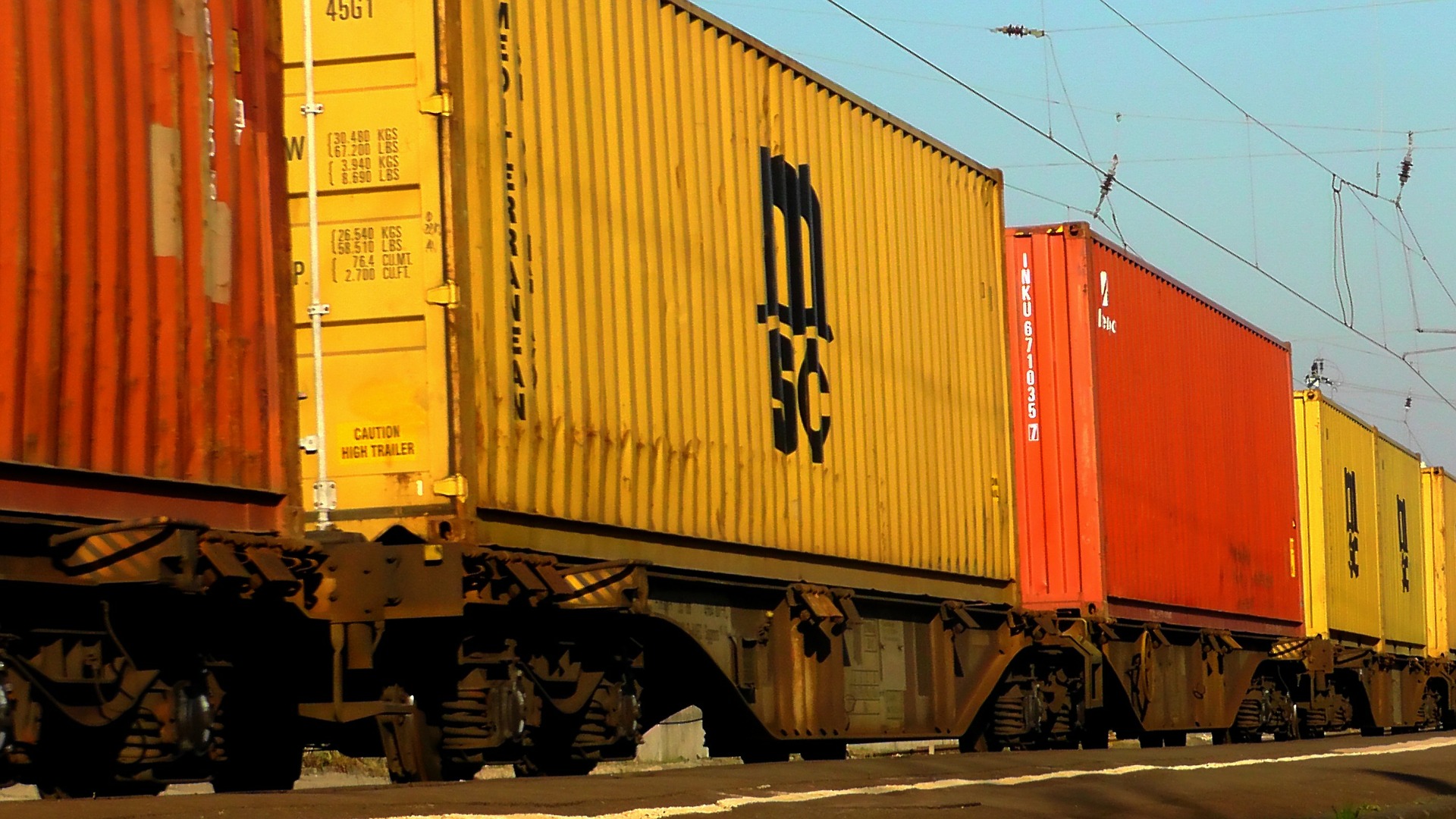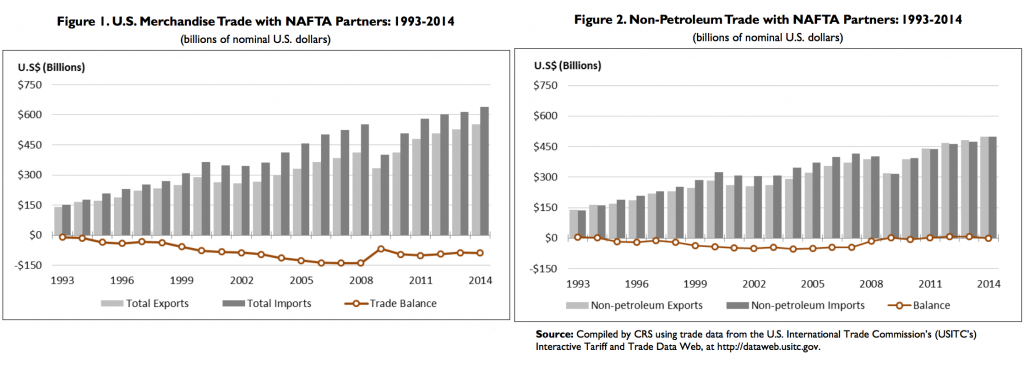
President Donald Trump made repealing or renegotiating trade deals a signature promise during his run for office, singling out the North American Free Trade Agreement (NAFTA) as “the worst trade deal maybe ever signed anywhere.”
NAFTA was first implemented on January 1, 1994, removing most tariffs (taxes on goods that cross borders) and other barriers to trade in North America over the next few years. How it impacted the economies of the three members – Canada, Mexico and the United States – and what effect it had on jobs is often a subject of conjecture. This review of recent research and statistical resources may help journalists writing about possible changes to the pact.
Negotiated by Republican President George H.W. Bush and signed into law by Democratic President Bill Clinton, NAFTA has drawn the economies of its three members closer than ever by reducing import tariffs.
Critics say the agreement outsources American jobs to Mexico, where they are cheaper. Proponents argue that it benefits everyone: If a car factory closes in Michigan and moves to Mexico, workers who lost their jobs will be retrained for other work, goes this argument, while cars will be cheaper for everyone. In reality, some people end up very hurt by such adjustments, some benefit somewhat, and others gain disproportionately (think, respectively: a laid-off Ford worker, Ford buyers and Ford shareholders). But academics generally agree that NAFTA has done little to affect overall employment in the U.S.
According to a 2015 review by the Congressional Research Service (CRS), a non-partisan government office that provides research for lawmakers, NAFTA “did not cause the huge job losses feared by the critics or the large economic gains predicted by supporters. The net overall effect of NAFTA on the U.S. economy appears to have been relatively modest, primarily because trade with Canada and Mexico accounts for a small percentage of U.S. GDP.” Moreover, not all the increase in trade among members can be attributed to NAFTA, the CRS points out: “many of these changes may have taken place with or without” the agreement.
Nevertheless, today NAFTA impacts just about everything else, from sweet potato prices to sulfur dioxide emissions. Does it work as planned? What would ripping it up — and thus imposing import taxes on goods from Canada and Mexico — mean?
Wages and jobs
One of the biggest questions about NAFTA and similar free-trade agreements is if and how they impact American wages and jobs.
In a 2014 review, economists at Yale and the Federal Reserve Board found wages rose in all three NAFTA countries, especially Mexico and Canada. But as wages grew, exports became more expensive to buyers abroad, dampening demand for these goods. Taken together, the review found Mexico benefited the most from NAFTA (its overall welfare increased by 1.31 percent), the U.S. benefited slightly (0.08 percent) and Canada was made slightly worse (negative 0.06 percent). Over the same period, however, a reduction in international tariffs, despite the NAFTA effect, improved the welfare in all three countries, the authors argue.
This 2016 paper finds earnings for American blue collar workers in some manufacturing industries and their localities (so, a restaurant worker near a closed car factory) fell dramatically after NAFTA was implemented. Another 2016 paper by the same authors points to a fall in earnings for married blue-collar women.
This 2015 paper finds that jobs did not flourish in Mexico, as promised, and that NAFTA kindled income inequality in both Mexico and the U.S.
Other studies of job losses over this period attribute most to the rise of China as a manufacturing powerhouse and to trade deals that allowed Chinese goods to undercut goods made in North America.
Inputs and supply chains
Often misunderstood or ignored is the fact that when a car is made in Mexico, many of the components are imported, often from the U.S. These two countries don’t only sell each other products, but build them together with supply chains that straddle their border. Such intermediate goods – radiators, say – are created by American workers.
According to the International Trade Administration, a wing of the U.S. Department of Commerce, “a full 40 percent of the content of Mexican exports is comprised of U.S. inputs. That means that of all the products that Americans buy that are manufactured in Mexico, an average of 40 percent of those products’ value-added components are made here in the United States.”
A 2010 paper from the National Bureau of Economic Research supports that calculation, noting the figure is 25 percent for Canada and much lower for all other countries. By comparison, U.S. inputs in Chinese products imported into the United States are worth 4.3 percent of the total.
Balance of trade
When politicians don’t like a trade policy, they often speak of “trade deficits” – the difference (in this case negative) between what we sell a country and what that country sells us. This figure is also known as the “balance of trade.” When it is positive, it is a “surplus.”
This figure can be skewed by one large industry, such as oil – Canada’s largest export to the United States, notes the Congressional Research Service (CRS) review: “Approximately 16 percent of total trade with NAFTA partners is in petroleum products. Canada and Mexico accounted for 46 percent ($110.9 billion) of total U.S. crude oil imports ($241.8 billion) in 2014. Canada is the leading supplier of crude petroleum oil to the United States, followed by Saudi Arabia and Mexico.”
Without petroleum, the U.S. balance of trade with its NAFTA partners is roughly even, meaning it imports and exports goods worth about the same amount. These graphs are from the CRS report:
Balance of trade figures are available from the International Trade Commission – an independent federal body – as well as the U.S. Census Bureau (Canada and Mexico). Another source is the World Trade Organization, which reports that America buys over 81 percent of Mexico’s exports and 76 percent of Canada’s. Mexico is America’s second-largest goods export market (meaning the U.S. sends a lot of stuff to Mexico, but not necessarily services), according to the U.S. Trade Representative, which develops and coordinates American trade policy. Canada is America’s top export market for goods.
Agriculture
NAFTA has had a “profound” impact on American farming and food production, the U.S. Department of Agriculture (USDA) said in a 2015 review of the agreement’s first 20 years. It removed all tariffs and quotas on agricultural products traded between the U.S. and Mexico and almost all products they trade with Canada. Like the automotive industry, the trade includes raw and intermediate goods that shuttle between processing facilities in all three countries. The paper includes details on many different aspects of agriculture. Academics, too, have written dozens of papers on specific agricultural goods, including sugar and sweet potatoes, tomatoes and meat, to name a few.
Environment
How NAFTA has impacted environmental regulations in North America is also frequently the subject of academic enquiry. This 2017 paper found a relationship between NAFTA and a reduction in American manufacturers’ release of pollutants – particulate matter and sulfur dioxide – into the atmosphere. “Nearly two-thirds of the aggregate reductions in the emissions of both pollutants from U.S. manufacturing in the first five years following NAFTA can be attributed to the effects of the agreement,” the paper declares.
That may be true in the U.S., but other researchers have suggested that NAFTA shifted polluters over the border to Mexico.
Tearing up the agreement
Should the U.S. wish to tear up the NAFTA agreement, its partners may cause it to reconsider. Back in 2009, when the U.S., seeking to protect American drivers, banned Mexican trucks from crossing the border, Mexico slapped tariffs on dozens of American products made in the states whose legislators voted for the truck ban, including shampoo and Christmas trees. The U.S. backed down in 2011.
Research cited:
- Alexander, Klint W.; Soukup, Bryan J. “Obama ‘s First Trade War: The US-Mexico Cross Border Trucking Dispute and the Implications of Strategic Cross-Sector Retaliation on U.S. Compliance under NAFTA.” Berkeley Journal of International Law, 2010.
- Blecker, Robert A. “The Mexican and U.S. Economies After Twenty Years of NAFTA.” International Journal of Political Economy, 2015.
- Caliendo, Lorenzo; Parro, Fernando. “Estimates of the Trade and Welfare Effects of NAFTA.” Review of Economic Studies, 2014.
- Cherniwchan, Jevan. “Trade Liberalization and the Environment: Evidence from NAFTA and U.S. Manufacturing.” Journal of International Economics, 2017
- Hakobyan, Shushanik; McLaren, John. “Looking for Local Labor Market Effects of NAFTA.” Review of Economics and Statistics, 2016. doi: 10.1162/REST_a_00587.
- Hakobyan, Shushanik; McLaren, John. “NAFTA and the Gender Wage Gap.” American Economic Association working paper, 2016.
- Koopman, Robert; et al. “Give Credit Where Credit Is Due: Tracing Value Added in Global Production Chains.” NBER Working Paper, 2011.
- Lee, Youngjae; Kennedy, P. Lynn. “Determining the Effect of NAFTA on the North American Sweet Potato Market.” Presented at the Agricultural & Applied Economics Association Annual Meeting, 2016.
- Schmitz, Troy G.; Lewis, Karen E. “Impact of NAFTA on U.S. and Mexican Sugar Markets.” Journal of Agricultural and Resource Economics, 2015
- Villarreal, M. Angeles; Fergusson, Ian F. “The North American Free Trade Agreement (NAFTA).” Congressional Research Service, 2015.
- Zahniser, Steven; et al. “NAFTA at 20: North America’s Free-Trade Area and Its Impact on Agriculture.” Economic Research Service, USDA, 2015.
Other resources:
- Journalist’s Resource has reviewed research about free trade’s impact on American jobs, the proposed Trans-Pacific Partnership and other aspects of trade.
- The U.S. Trade Representative has this NAFTA fact sheet and the U.S. Customs and Border Protection office has this one.
- This NAFTA fact page is managed by the three member countries.
- This briefing by a professor at Texas A&M University discusses popular misconceptions of NAFTA.
- A 2016 study by the nonpartisan Congressional Budget Office called the impact of trade agreements like NAFTA on the U.S. balance of trade “very small and highly uncertain.”
Keywords: globalization, jobs, free trade, wages, protectionism, economic nationalism

